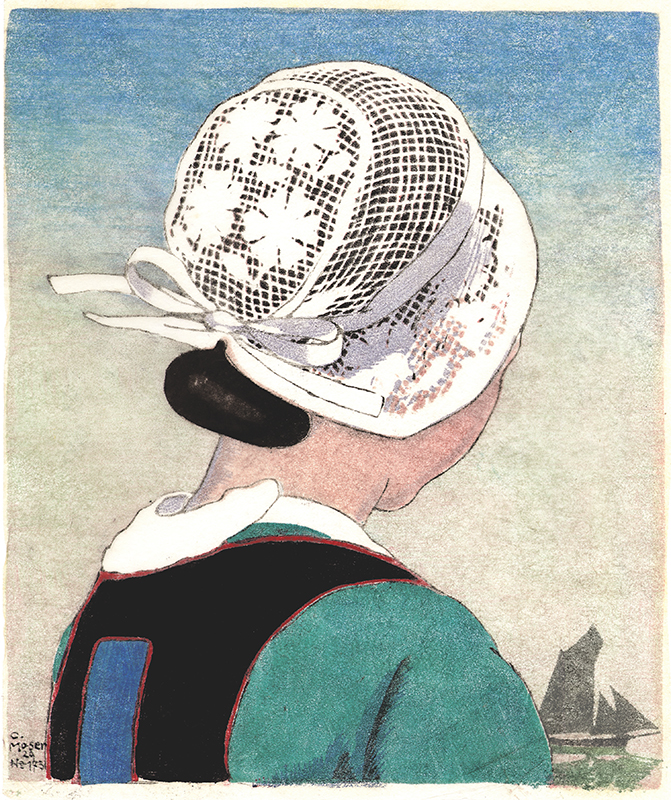Bretonisches Mädchen is a color woodcut by Carl Moser. It is ink signed and dated [19]29 in the lower left image. The origin of the blocks date to 1904 but Moser returned to this image time and time again, varying the background. The references are CM 15 and Kirschl HS 9. This impression is number 173 but the full edition is unstated. It was printed by the artist in nine colors on thin Japanese paper. The image measures 11-5/8 by 9-7/8 inches.
The customs and the clothing of the people of coastal region of Brittany inspired Moser and influenced numerous color woodcuts spanning his career. He was captivated by the elaborate shawls and lacey headwear worn by Breton women. Moser returned to the image of the young woman in Bretonisches Mädchen for numerous color woodcuts between 1904 and 1930. He changed his color palette but also his background blocks—some woodcuts have a flat sky with a low horizon and sailboats in the lower right while others have the town of Tréboul on the distant bank. Moser produced numerous variations on the same theme in differing sizes and formats.
Carl Moser, painter and printmaker,
was born in Bolzano, South Tyrol, on January 27, 1873, the son of painter Karl
Moser. His formal art training began at the Akademie der Bildenden Künste,
Munich, where he studied under Karl Raupp, Gabriel von Hackl, and Ludwig von
Herterich. He had established himself as an up-and-coming Austrian artist by
the late 1890s and, in 1897, co-founded the Vienna Secession movement with
Maxmilian Kurzweil, Gustav Klimt, Koloman Moser, Joseph Olbrich, and Josef
Hoffman. His work was especially lauded by Kurzweil, editor of the Secession
periodical Ver Sacrum and
the person often credited with encouraging Moser to learn the color woodcut
technique.
Following his years at the Akademie, Moser spent time travelling in Germany, Italy and Corsica before settling in Paris in 1901. While there he first learned of ukiyo-e, the Japanese woodcut style that had gained wild popularity throughout Europe by 1900. Moser traveled to Brittany every summer, where the coastal towns and people soon became a source of great inspiration and one that he returned to throughout his career. In 1906, he enrolled at the Académie Julian, where he studied for a year before financial difficulties forced him to return to Bolzano.
Moser’s main focuses became Japanese woodcut and French Impressionism, and he became known for his richly hued, sensitive imagery depicting the daily life of coastal Bretons. His work soon garnered recognition by the Viennese government and several of his woodcuts were purchased by the Albertina Museum between 1910 and 1915. In 1914 he exhibited his work at the International Exhibition for Book Trade and Graphics in Leipzig, and he showed frequently in Vienna's leading galleries, such as Galerie Miethke.
After the end of World War I and the signing of teh 1919 Treaty of Saint-Germain-en-Laye, South Tyrol, which had been part of Austria,
was ceded to Italy. Moser and many other South Tyrolean artists were forced to
change their nationality to Italian, and could no longer exhibit in Austria and
Germany. Unable to maintain his professional relationships with dealers in
Austria and Germany, Moser was effectively cut off from his source of income
and reputation. Though attempts were made to revive the careers of Tyrolean
artists after the war—including a major exhibition in Zurich in 1920—Moser had
to focus solely on Italian exhibitions until the relaxation of the laws in the
mid 1920s. By then, however, the damage had been done—Moser was no longer a
leading artist in the now rapidly changing Europe, and age had lessened his
ability to travel and self-promote. He continued to show in the Venice Biennale
until 1936, but failing health rendered him unable to continue working. Moser
became isolated and, despite having been one of the most influential Austrian
color woodcut artists of his time, he died in poverty and obscurity in Bolzano
on June 23, 1939.
Four decades later, Moser's work was rediscovered and celebrated with a major retrospective in Innsbruck in 1978. His work can be found in the Albertina Museum in Vienna; the British Museum, London; and the Oglethorpe University Museum of Art, Brookhaven, Georgia.



